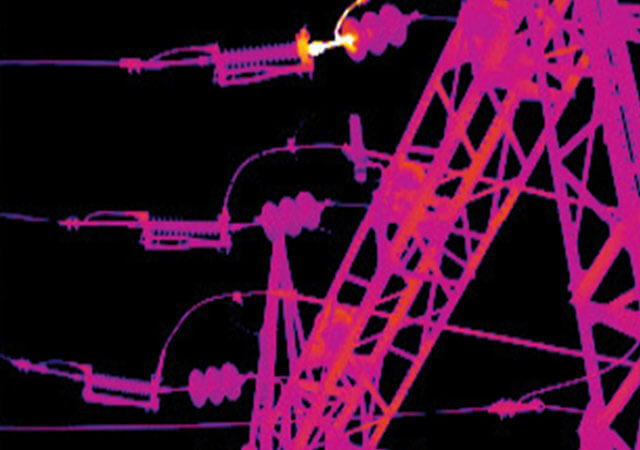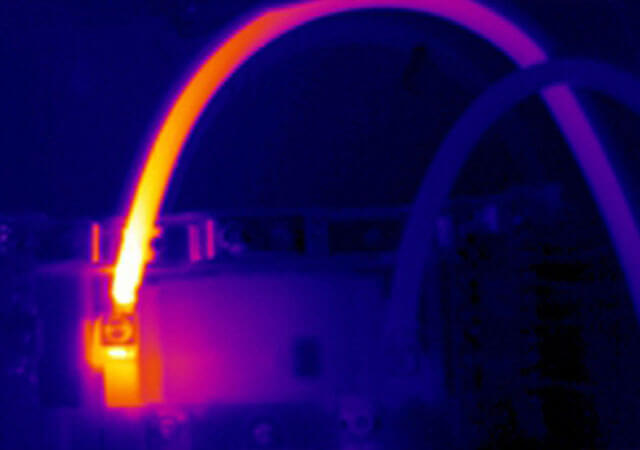In all over the world, infrared thermal imager has become the core tool of preventive maintenance detection in the power industry. Tens of thousands of power companies around the world are using infrared thermal imagers to avoid costly failures, improve operational reliability and avoid electrical fires.
There are many kinds of faults in power equipment, but most of them are accompanied by overheating. From the perspective of infrared diagnosis, it is usually divided into external fault and internal fault. As we all know, in the operation of power system, current carrying conductor will produce resistance loss due to current effect, and there are a large number of connectors, joints or contacts in the whole circuit of power transmission. Ideally, the contact resistance of various connectors, joints or contacts in the transmission circuit is lower than that of the connected conductor. Then, the loss heating of the connection part will not be higher than that of the adjacent current carrying conductor. However, once the contact resistance of some connectors, joints or contacts increases due to poor connection, there will be more resistance loss and higher temperature rise in this part, resulting in local overheating. This is usually an external fault.
The characteristics of external faults are: local temperature rise, easy to use infrared thermal imager to find, if not handled in time, the situation worsens quickly, it will be easy to form accidents and result in losses. The proportion of external faults in power accidents is large.
The so-called internal fault of high-voltage electrical equipment mainly refers to the fault of electrical circuit enclosed in solid insulation and equipment shell and various faults caused by insulation medium deterioration. Because this kind of fault occurs in the interior of the electrical equipment, the temperature rise reflected on the exterior of the equipment is very small, usually only a few K. The detection of this kind of fault requires high sensitivity of detection equipment.
The characteristics of internal faults are: small proportion of faults, small temperature rise, great harm, high requirements for infrared detection equipment.
According to the long-term measured data and comprehensive statistics of a large number of cases provided by relevant units, the external thermal defects of power equipment generally account for 90% - 93% of the total defect index of equipment, and the internal thermal defects only account for about 7% - 10%.
The power industry is the first in the civilian field to use the thermal imager in the safety maintenance of equipment, through which the thermal defects of electrical equipment and lines are detected, such as transformer, bushing, circuit breaker, knife switch, transformer, power capacitor, lightning arrester, power cable, bus, conductor, combined electrical apparatus, insulator string, low-voltage electrical apparatus and current, voltage induced thermal effect It is very important and effective to detect, deal with and prevent the occurrence of major accidents in time.
Example 1: This is a substation in the center of the city, which is responsible for supplying power to a nearby hospital and surrounding residential areas. We use infrared thermal imager to detect the contact of substation, and find a hot contact in the infrared image. The temperature measured by long focus lens is 437 ℃. It is difficult to detect the fault of high-altitude tower because of its strong concealment, and the use of infrared thermal imager can make the detection workers find this thermal anomaly timely and easily.

Example 2: also in this substation, we use infrared thermograph
The circuit breaker in the substation box was detected, and a hidden danger of overheating contact was found. So as to effectively avoid the occurrence of a malignant power accident.

The application of infrared temperature measurement thermal imager, a non-contact random non-destructive testing equipment, is timely, convenient, low operation intensity, no need to power off, does not affect the normal use of power users, and ensures the operation safety of testing operators to the greatest extent, creating great economic and social benefits. Therefore, since the 1980s, once applied, it has been widely recognized and promoted by the power sector.
Go Top